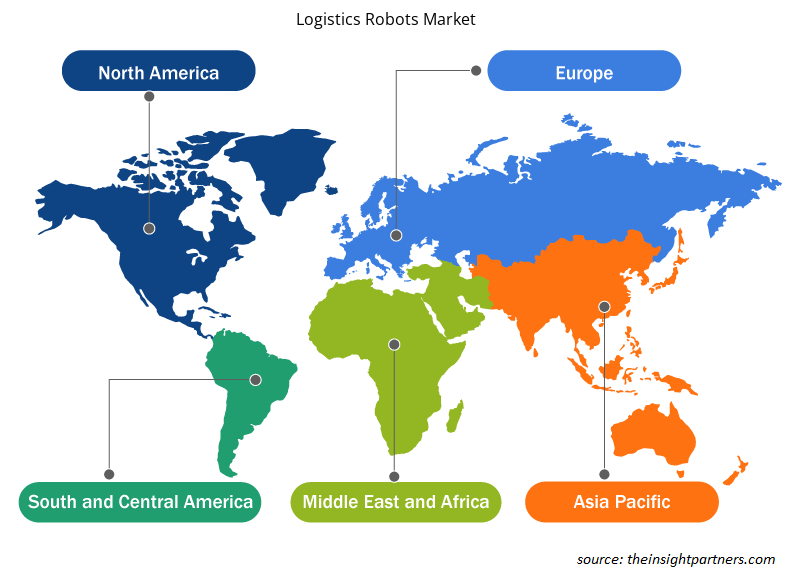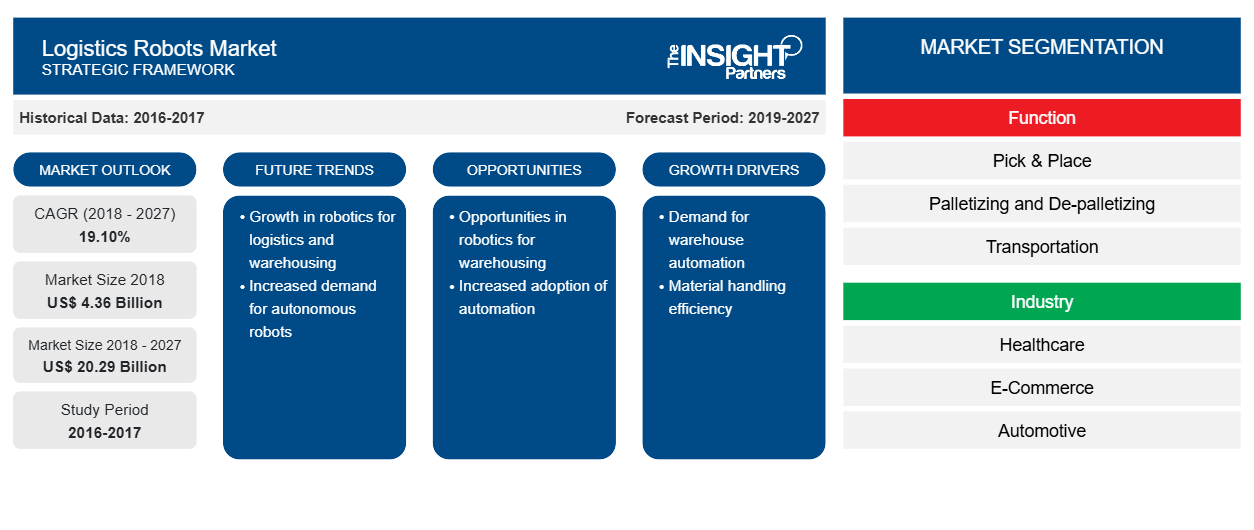物流ロボット市場は2018年に43億5,620万米ドルと評価され、2019年から2027年にかけて年平均成長率19.10%で成長し、2027年までに202億9,340万米ドルに達すると予想されています。
市場で競争力を維持するために、効率、スピード、利益増大のメリットを得るためにロボットの導入に力を入れている物流・倉庫会社の数が増加しています。手頃な価格で業務効率を高めるために、ロボット倉庫・物流技術などの先進技術の採用が増えています。世界の物流ロボット市場は、世界的な高齢化人口の増加による労働力不足や世界的なサプライチェーンネットワークの拡大などの要因によって推進されていますが、物流ロボットの導入に向けた多額の設備投資が、予測期間中の物流ロボット市場の成長を抑制すると予想されています。しかし、倉庫自動化の増加とアジア太平洋地域および欧州諸国での確立された市場は、近い将来、業界プレーヤーの市場シェアを向上させる大きな成長機会をもたらす可能性があります。
市場分析
世界的に高齢化率が上昇し、労働力不足に陥る
世界中で高齢化率が増加していることは、さまざまな業界で労働力の削減につながる主な要因の 1 つです。世界中の各国で、地域社会の高齢者数が急増しています。人口の高齢化は、労働市場や金融市場を含むすべてのセクターで、21 世紀の社会変革の重要な要因の 1 つとなっています。ただし、イタリア、日本など、多くの国では、65 歳以上の人口がかなりの割合を占めており、高齢化率の最大値を挙げている国があります。WHO によると、2050 年までに世界中で約 200 万人が 60 歳以上になると予想されており、これは 2000 年の 3 倍に相当します。高齢化人口の急増は、労働力不足の原因となっています。物流ロボットを複数の業界で導入することは、プロセス全体のコストを削減し、生産性を高め、安全性を高め、人的エラーを減らすため、重要な役割を果たします。世界中の倉庫における急速な技術進歩は、サプライチェーン プロセスが直面する困難に関連する要件に焦点を当て、ビジネス目標に関連する技術の使用を保証しています。製品ライフサイクルのさまざまなユニット、機能、段階にわたるロボットの実装は、今日の倉庫が成長の過程で直面する重要な課題であり、近い将来、物流ロボット市場を後押しすることになります。
要件に合わせてレポートをカスタマイズする
このレポートの一部、国レベルの分析、Excelデータパックなど、あらゆるレポートを無料でカスタマイズできます。また、スタートアップや大学向けのお得なオファーや割引もご利用いただけます。
- このレポートの主要な市場動向を入手してください。この無料サンプルには、市場動向から見積もりや予測に至るまでのデータ分析が含まれます。
ロボットタイプの洞察
協働型モバイルロボット部門は、世界の物流ロボット市場で最大のシェアを獲得しました。これらの協働ロボットは、重作業だけでなく軽作業もこなすほど熟練しているため、梱包、機械管理、材料処理など、さまざまなタスクを実行するためにさまざまな業界で導入されています。これらのロボットは、非常に正確で柔軟性があり、精密です。さらに、協働ロボットはメンテナンスが簡単で、再構成や再プログラムがより簡単になります。これらのロボットは繊細な作業も処理でき、さらに、製造プロセス中に発生する不一致に応じて自動的に調整します。協働ロボットは、オンボード分析とレポートを提供するための重要な指標を収集して意思決定プロセスを簡素化できるため、物流ロボット市場全体が推進されています。
機能の洞察
輸送部門は、世界の物流ロボット市場で最大のシェアを獲得しました。商品はパレットに積まれ、さまざまな製品の形状とサイズにわずかなばらつきがあるため、これらの商品の積み下ろしの自動化が必要でした。3Dレーザービジョンは新しいロボットソフトウェアに統合されており、コンテナ内のさまざまな製品を視覚化し、理想的な積み込み/積み下ろしシーケンスを決定し、プロセスを高精度で実行するのに役立ちます。物流ロボットは、ターゲットラックの移動、バスケットの引き出しと持ち上げ、棚のフォークの伸張、ターゲット位置への復帰に使用され、物流ロボット市場全体を牽引しています。
業界の洞察
アウトソーシングされた物流セグメントは、世界の物流ロボット市場で最大のシェアを獲得しました。これらの物流サービスプロバイダーは、倉庫保管、在庫管理、輸送、配送、注文処理、貨物統合など、さまざまなサービスを提供しています。タイムリーな配送管理と配送コスト削減に対する需要はますます高まっており、材料の在庫記録の維持に重点が置かれ、コアビジネスと会社の資産の削減が予測期間中に物流ロボット市場を牽引すると予想されています。
企業は、世界中で事業を拡大し、高まる需要に対応するために、いくつかの市場イニシアチブ戦略を一般的に採用しています。この戦略は、主にヨーロッパとアジア太平洋地域で採用されています。物流ロボット市場のプレーヤーは、世界中の顧客基盤を拡大するために、研究開発への拡張と投資の戦略を採用しており、これによりプレーヤーは世界的にブランド名を維持することもできます。
物流ロボット市場の地域別分析
予測期間を通じて物流ロボット市場に影響を与える地域的な傾向と要因は、Insight Partners のアナリストによって徹底的に説明されています。このセクションでは、北米、ヨーロッパ、アジア太平洋、中東、アフリカ、南米、中米にわたる物流ロボット市場のセグメントと地理についても説明します。

- 物流ロボット市場の地域別データを入手
物流ロボット市場レポートの範囲
| レポート属性 | 詳細 |
|---|---|
| 2018年の市場規模 | 43億6千万米ドル |
| 2027年までの市場規模 | 202.9億米ドル |
| 世界のCAGR(2018年 - 2027年) | 19.10% |
| 履歴データ | 2016-2017 |
| 予測期間 | 2019-2027 |
| 対象セグメント | 機能別
|
| 対象地域と国 | 北米
|
| 市場リーダーと主要企業プロフィール |
|
市場プレーヤーの密度:ビジネスダイナミクスへの影響を理解する
物流ロボット市場は、消費者の嗜好の変化、技術の進歩、製品の利点に対する認識の高まりなどの要因により、エンドユーザーの需要が高まり、急速に成長しています。需要が高まるにつれて、企業は提供を拡大し、消費者のニーズを満たすために革新し、新たなトレンドを活用し、市場の成長をさらに促進しています。
市場プレーヤー密度とは、特定の市場または業界内で活動している企業または会社の分布を指します。これは、特定の市場スペースに、その市場規模または総市場価値に対してどれだけの競合相手 (市場プレーヤー) が存在するかを示します。
物流ロボット市場で事業を展開している主要企業は次のとおりです。
- AGVインターナショナル
- クリアパスロボティクス
- 株式会社ダイフク
- ファナック株式会社
- フェッチロボティクス株式会社
免責事項:上記の企業は、特定の順序でランク付けされていません。

- 物流ロボット市場のトップキープレーヤーの概要を入手
物流ロボット市場 – ロボットタイプ別
- ロボットアーム
- 無人搬送車
- 協働型移動ロボット
- その他
物流ロボット市場 – 機能別
- ピックアンドプレース
- パレタイジングとデパレタイジング
- 交通機関
- パッケージ
物流ロボット市場 – 業界別
- 健康管理
- 電子商取引
- 自動車
- 物流アウトソーシング
- 小売り
- 消費財
- 食品・飲料
- その他
物流ロボット市場 – 地域別
北米
- 私たち
- カナダ
- メキシコ
ヨーロッパ
- フランス
- ドイツ
- イタリア
- 英国
- ロシア
- その他のヨーロッパ
アジア太平洋
- 中国
- インド
- 韓国
- 日本
- オーストラリア
- その他のアジア太平洋地域
中東・アフリカ
- 南アフリカ
- サウジアラビア
- アラブ首長国連邦
- その他の中東およびアフリカ
南アメリカ
- ブラジル
- アルゼンチン
- 南米のその他の地域
企業プロフィール
- AGVインターナショナル
- クリアパスロボティクス
- 株式会社ダイフク
- ファナック株式会社
- フェッチロボティクス株式会社
- キオングループAG
- ナップAG
- コルモルゲン
- クーカAG
- 株式会社東芝
- 過去2年間の分析、基準年、CAGRによる予測(7年間)
- PEST分析とSWOT分析
- 市場規模価値/数量 - 世界、地域、国
- 業界と競争環境
- Excel データセット



Report Coverage
Revenue forecast, Company Analysis, Industry landscape, Growth factors, and Trends

Segment Covered
This text is related
to segments covered.

Regional Scope
North America, Europe, Asia Pacific, Middle East & Africa, South & Central America

Country Scope
This text is related
to country scope.
よくある質問
Automated guided vehicles (AGVs) are used for consistent as well as predicted transport of materials. AGVs might be serviced through conveyors, forklift trucks, or manual cart transport systems. The transport of bulk materials using AGVs helps minimize efforts required in repetitive transportation of small chunks of materials, with less human intervention. Apart from distribution and manufacturing, AGVs have also become an integral part of other industries, including retail, military, food & beverages, automotive, and healthcare. The deployment of AGVs benefits businesses by reducing the cost of labor required in manual execution of tasks; enhancing safety, accuracy, and productivity of products; and improving the efficiency of work when integrated with the warehouse management/control systems. Improved work efficiencies further helps streamline other processes, such as materials ordering and inventory management.
With the increasing importance of equipment in logistic markets in APAC, especially China and India, robot manufacturers realize that electronics innovations can complement production innovations in gaining a competitive advantage. Japan is a well-developed economy and is one of the most technologically advanced economies across the world. Also, the region has a few significant manufacturers of robots and factory automation systems such as Fanuc, Mitsubishi Electric, and Omron Corp, among others. The Japanese companies widely use automation solutions to maintain their competitive position in the market.
The continuous growth in consumer expectations is likely to drive continued investment for the adoption of logistics robots for performing operational functions in warehouses. Leveraging the modern supply chain technology as well as the Internet of Things (IoT), the focus on the “smart warehouse†concept is growing, which can serve as a hub to enhance the efficiency and speed of the entire supply chain process. The warehouse automation includes wearable wore by workers to sensors, logistics robots, internet-enabled devices, and smart equipment, which profoundly modify the logistics management. Warehouse management is constantly facing more pressures related to supply chain transformation, commoditization, and rising customer expectations. Therefore, the warehouse automation concept is an effective way to enhance efficiencies, reduce operational costs, and scale operations. The warehouse automation performs various activities such as data collection and inventory control, with million-dollar of investments.
Trends and growth analysis reports related to Electronics and Semiconductor : READ MORE..
The List of Companies - Logistics Robots Market
- AGV International
- Clearpath Robotics
- Daifuku Co. Ltd.
- Fanuc Corporation
- Fetch Robotics Inc
- KION GROUP AG
- KNAPP AG
- Kollmorgen
- Kuka AG
- Toshiba Corporation
The Insight Partners performs research in 4 major stages: Data Collection & Secondary Research, Primary Research, Data Analysis and Data Triangulation & Final Review.
- Data Collection and Secondary Research:
As a market research and consulting firm operating from a decade, we have published and advised several client across the globe. First step for any study will start with an assessment of currently available data and insights from existing reports. Further, historical and current market information is collected from Investor Presentations, Annual Reports, SEC Filings, etc., and other information related to company’s performance and market positioning are gathered from Paid Databases (Factiva, Hoovers, and Reuters) and various other publications available in public domain.
Several associations trade associates, technical forums, institutes, societies and organization are accessed to gain technical as well as market related insights through their publications such as research papers, blogs and press releases related to the studies are referred to get cues about the market. Further, white papers, journals, magazines, and other news articles published in last 3 years are scrutinized and analyzed to understand the current market trends.
- Primary Research:
The primarily interview analysis comprise of data obtained from industry participants interview and answers to survey questions gathered by in-house primary team.
For primary research, interviews are conducted with industry experts/CEOs/Marketing Managers/VPs/Subject Matter Experts from both demand and supply side to get a 360-degree view of the market. The primary team conducts several interviews based on the complexity of the markets to understand the various market trends and dynamics which makes research more credible and precise.
A typical research interview fulfils the following functions:
- Provides first-hand information on the market size, market trends, growth trends, competitive landscape, and outlook
- Validates and strengthens in-house secondary research findings
- Develops the analysis team’s expertise and market understanding
Primary research involves email interactions and telephone interviews for each market, category, segment, and sub-segment across geographies. The participants who typically take part in such a process include, but are not limited to:
- Industry participants: VPs, business development managers, market intelligence managers and national sales managers
- Outside experts: Valuation experts, research analysts and key opinion leaders specializing in the electronics and semiconductor industry.
Below is the breakup of our primary respondents by company, designation, and region:

Once we receive the confirmation from primary research sources or primary respondents, we finalize the base year market estimation and forecast the data as per the macroeconomic and microeconomic factors assessed during data collection.
- Data Analysis:
Once data is validated through both secondary as well as primary respondents, we finalize the market estimations by hypothesis formulation and factor analysis at regional and country level.
- Macro-Economic Factor Analysis:
We analyse macroeconomic indicators such the gross domestic product (GDP), increase in the demand for goods and services across industries, technological advancement, regional economic growth, governmental policies, the influence of COVID-19, PEST analysis, and other aspects. This analysis aids in setting benchmarks for various nations/regions and approximating market splits. Additionally, the general trend of the aforementioned components aid in determining the market's development possibilities.
- Country Level Data:
Various factors that are especially aligned to the country are taken into account to determine the market size for a certain area and country, including the presence of vendors, such as headquarters and offices, the country's GDP, demand patterns, and industry growth. To comprehend the market dynamics for the nation, a number of growth variables, inhibitors, application areas, and current market trends are researched. The aforementioned elements aid in determining the country's overall market's growth potential.
- Company Profile:
The “Table of Contents” is formulated by listing and analyzing more than 25 - 30 companies operating in the market ecosystem across geographies. However, we profile only 10 companies as a standard practice in our syndicate reports. These 10 companies comprise leading, emerging, and regional players. Nonetheless, our analysis is not restricted to the 10 listed companies, we also analyze other companies present in the market to develop a holistic view and understand the prevailing trends. The “Company Profiles” section in the report covers key facts, business description, products & services, financial information, SWOT analysis, and key developments. The financial information presented is extracted from the annual reports and official documents of the publicly listed companies. Upon collecting the information for the sections of respective companies, we verify them via various primary sources and then compile the data in respective company profiles. The company level information helps us in deriving the base number as well as in forecasting the market size.
- Developing Base Number:
Aggregation of sales statistics (2020-2022) and macro-economic factor, and other secondary and primary research insights are utilized to arrive at base number and related market shares for 2022. The data gaps are identified in this step and relevant market data is analyzed, collected from paid primary interviews or databases. On finalizing the base year market size, forecasts are developed on the basis of macro-economic, industry and market growth factors and company level analysis.
- Data Triangulation and Final Review:
The market findings and base year market size calculations are validated from supply as well as demand side. Demand side validations are based on macro-economic factor analysis and benchmarks for respective regions and countries. In case of supply side validations, revenues of major companies are estimated (in case not available) based on industry benchmark, approximate number of employees, product portfolio, and primary interviews revenues are gathered. Further revenue from target product/service segment is assessed to avoid overshooting of market statistics. In case of heavy deviations between supply and demand side values, all thes steps are repeated to achieve synchronization.
We follow an iterative model, wherein we share our research findings with Subject Matter Experts (SME’s) and Key Opinion Leaders (KOLs) until consensus view of the market is not formulated – this model negates any drastic deviation in the opinions of experts. Only validated and universally acceptable research findings are quoted in our reports.
We have important check points that we use to validate our research findings – which we call – data triangulation, where we validate the information, we generate from secondary sources with primary interviews and then we re-validate with our internal data bases and Subject matter experts. This comprehensive model enables us to deliver high quality, reliable data in shortest possible time.


 このレポートの無料サンプルを入手する
このレポートの無料サンプルを入手する